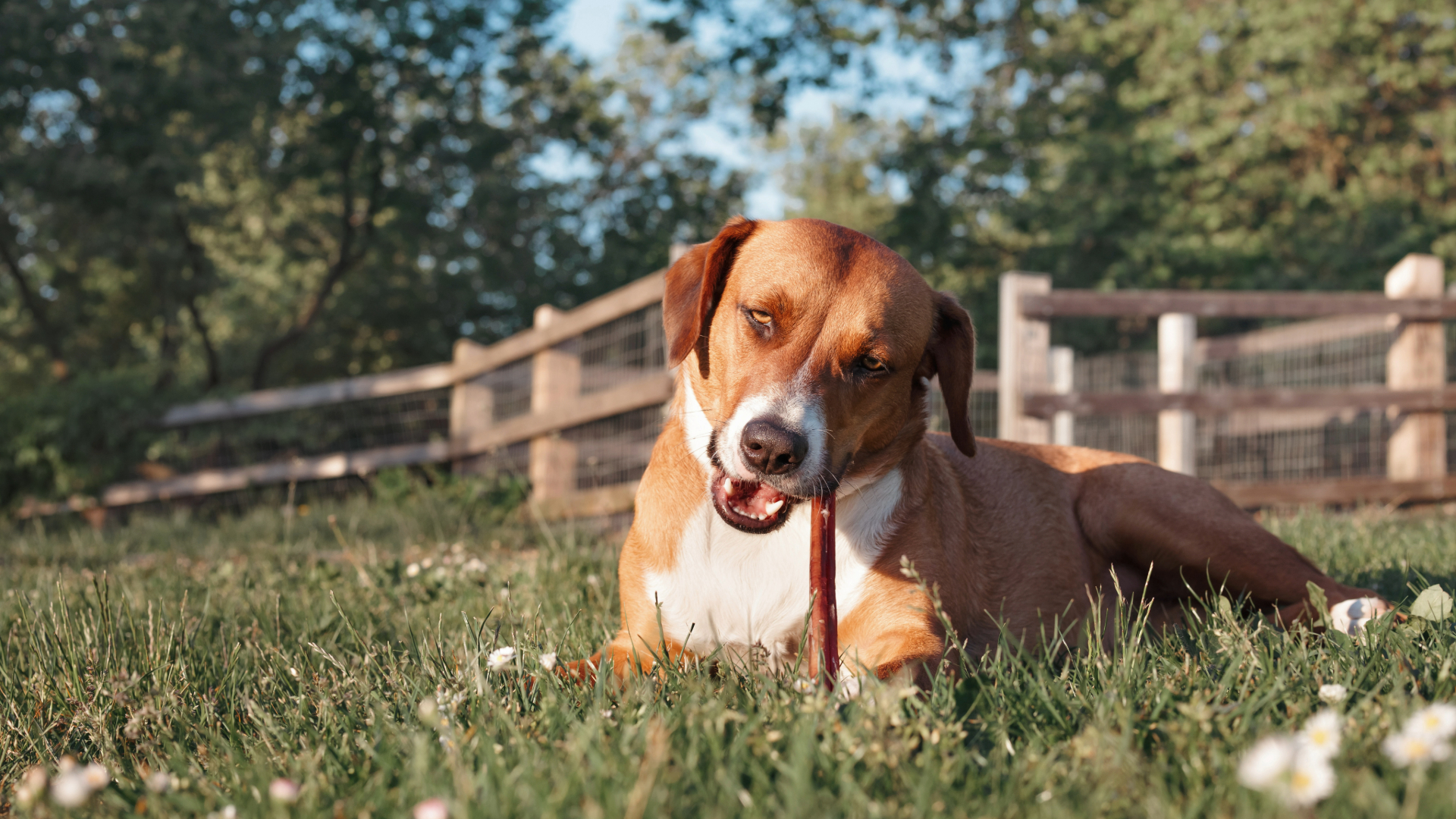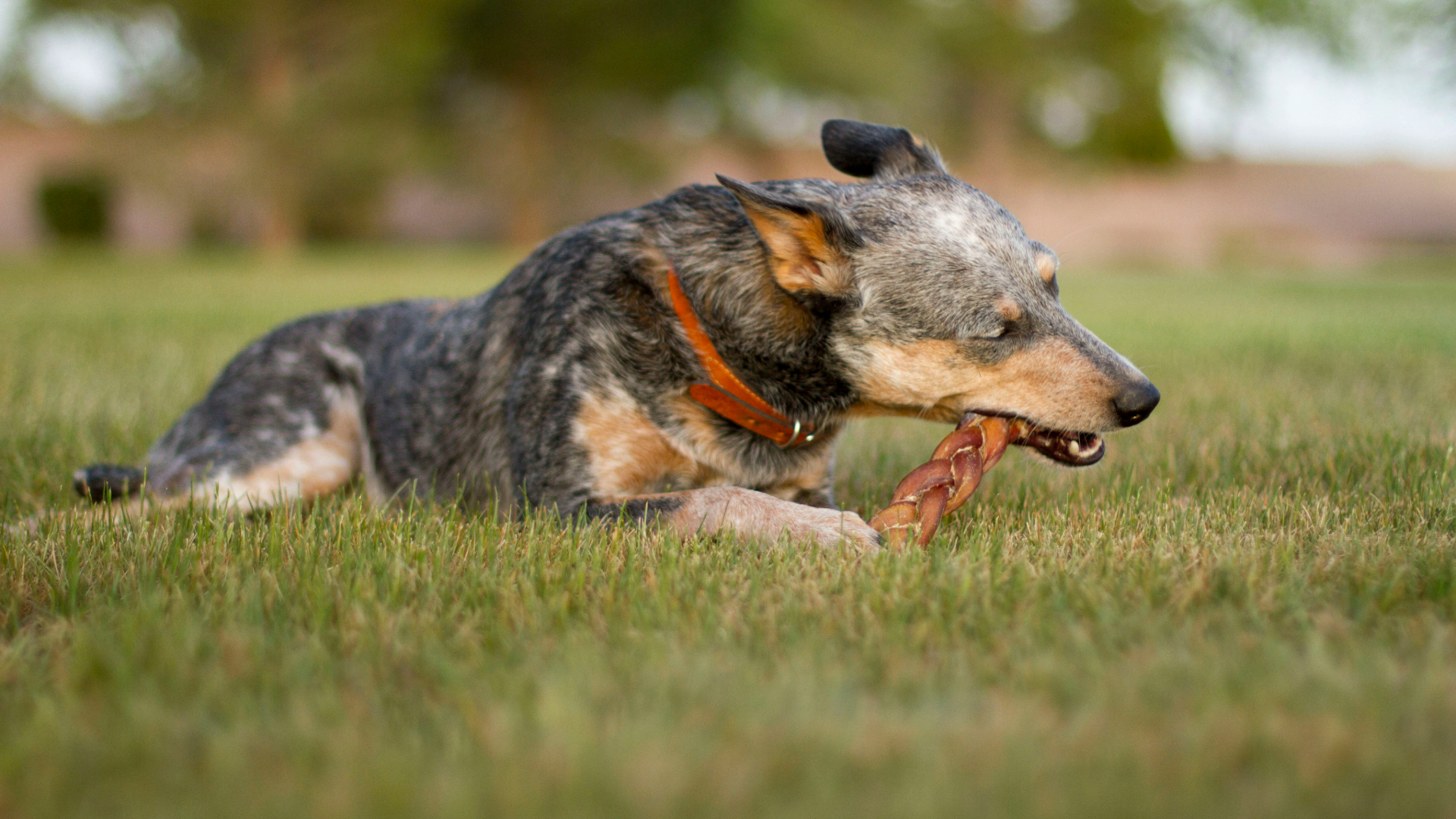
Wondering 'What are bully sticks made of?' There are a lot of dog chews on the market now, made of all sorts of things – we’ve moved on from the ubiquitous rawhide and pigs’ ears and onto a much more exotic selection – including bully sticks. But what on earth are they? And what are they made of?
I’ve been a vet for nearly nine years, and in that time, dog feeding has changed considerably. More and more people are looking for natural options for their pets, and I find myself being asked about all sorts of weird and wonderful dog chew options. In fact, I’ve spent a considerable amount of time researching these options to help me understand exactly what goes into bully sticks, lamb pizzles, and the rest of them!
If you don’t provide a safe and acceptable chewing outlet for your dog, you’ll likely find them chewing on something else – a table leg or slipper perhaps? – or displaying other destructive behaviors due to boredom. For that reason, I always recommend pet owners budget to provide the best long-lasting dog chews to their pets.
What are bully sticks made of?
Bully sticks are made from a surprising ingredient – bull (or steer) penises! When a male cow is slaughtered, the penis is removed, stretched, and then dried – either low and slow (dehydration) or by baking in an oven.
The drying process and the naturally cartilaginous nature of bull penises makes bully sticks a tough, long-lasting dog chew.

Do vets recommend bully sticks?
Obviously, I can’t speak for all vets, and even if I could they’d be unlikely to unanimously agree. But the way I see it is this – dogs need to chew, and every chew has pros and cons – bully sticks are no exception. There’s no such thing as a 100% safe chew – and the safest ones are sometimes less interesting to dogs, meaning they won’t use them.
I myself have a fussy dog who will merrily chew bully sticks, but nothing harder/safer – so it’s about finding a happy middle ground for you and your dog. To make it easier for you to navigate, I’ve listed the pros and cons of bully sticks below:
👍Benefits of bully sticks for dogs
- Natural: Unlike rawhide, bully sticks don’t usually need chemicals to process them, making them a more natural option.
- Mental health: As a moderately long-lasting dog chew, bully sticks are good for a dog's mental health, giving them a suitable outlet for their chewing needs.
- Dental health: Anything that encourages chewing can promote better dental health, and bully sticks are no exception.
- Single ingredient: For dogs with known food allergies, finding safe treats can be a problem. Unless your dog is allergic to beef protein, single-ingredient bully sticks can be a great option for these dogs.
👎Risks of bully sticks for dogs
- Choking: Because bully stick bits can come off in chunks, there’s a risk of choking. You’ll need to watch your dog’s chewing style to decide if they can have bully sticks.
- Obesity: Bully sticks are really energy-dense due to their fat content, so aren’t suitable for daily feeding. You’ll need to adjust your dog’s other treat portions accordingly to avoid obesity in dogs.
- Bacterial contamination: If the sticks have been dehydrated rather than baked, bacteria can survive on them. Salmonella is a particular concern and can affect your dog and humans they come into contact with.
Types of bully sticks for dogs
Bully sticks come in different lengths (usually six-inch and 12-inch), which describe their dried length. They also come in different thicknesses. For larger dogs, bully sticks can also be braided or shaped, making a thicker, larger chew.
They’re all still made with the same base ingredient, but if you’re looking for a different species, lamb pizzles are also available!

How to feed bully sticks safely
As with any treat, safety is key. Try to find chews that have been baked at a higher temperature, and whose manufacturers regularly test batches for bacterial contamination.
Choose the right size bully stick for your dog to make sure they don’t swallow large bits whole, and remove the final piece once they’ve chewed off the rest to reduce choking risk.
Lastly, watch your dog’s weight – bully sticks are nutrient-dense, so you’ll need to adjust the rest of their diet and check in with your vet regularly to make sure they aren’t getting too fat!
Hopefully, I’ve fully answered the question 'what are bully sticks made of?' (bull penises) and you now understand the pros and cons of feeding bully sticks to dogs. As for whether vets recommend bully sticks – I can’t speak for other vets, but my dog will continue to enjoy bully sticks.
On her bully stick days, I restrict my young daughter’s access to her to reduce the risk of her catching Salmonella from the stick or my dog. It’s all about finding the balance between risk and benefit, taking your own dog’s size and chewing style into account.
Read next: Safe dog chews for aggressive chewers and rawhide vs beefhide
Edited by Megan Milstead.







